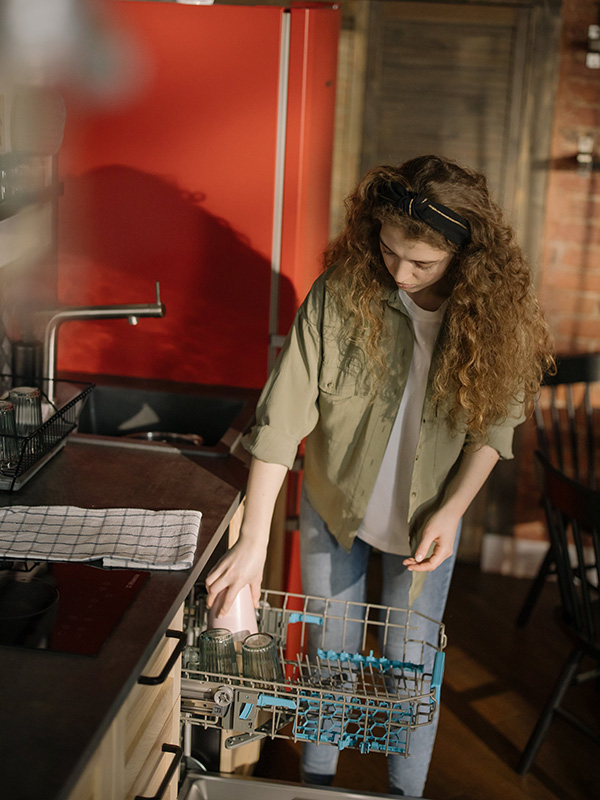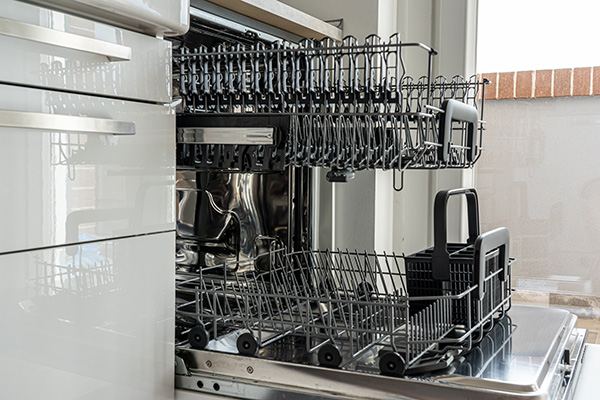Cleaning your dishwasher might not be a top priority, but it's a crucial task to maintain its efficiency and hygiene. Over time, food residues, grease, and limescale can build up, affecting your dishwasher's performance and even causing unpleasant odors. Regularly cleaning your dishwasher is crucial to keeping your kitchen appliances in optimal condition.
In this comprehensive guide, we will guide you through the steps to thoroughly clean your dishwasher, covering everything from debris removal to soap scum elimination and sanitization. Whether you're dealing with a funky-smelling machine or simply want to keep it in top shape, our step-by-step instructions will help you achieve a sparkling clean dishwasher and spotless dishes with every cycle.
How to Clean A Dishwasher
Cleaning your dishwasher is a straightforward process that can be done with just a few simple steps. Follow this guide to keep your dishwasher in top condition:
Materials
Distilled White vinegar
Baking soda
A soft brush or toothbrush
A microfiber cloth
A small, dishwasher-safe bowl

Introductions
Step 1: Empty the Dishwasher
Begin by ensuring your dishwasher is completely empty. Remove all dishes, utensils, and cookware from both the upper and lower racks. This step allows you full access to the dishwasher's interior for a thorough cleaning.
Step 2: Remove the Dish Racks
Start with an empty dishwasher. Take out the dish racks carefully. Typically, these refer to the upper and lower sections of the dishwasher where you load your dishes. Setting them aside will give you unobstructed access to the dishwasher's interior for cleaning.
Step 3: Clean the Dishwasher Filter
Most dishwashers have a removable dishwasher filter located at the bottom. Check your dishwasher's manual for specific instructions on how to remove it. After removal, rinse the filter under warm, running water. Utilize a soft brush or toothbrush to eliminate any stubborn particles or residues. Cleaning the filter ensures that water flows freely during the wash cycle, improving the dishwasher's performance. Reinsert the clean filter back into its place.
Step 4: Wipe Down the Interior
Moisten a microfiber cloth with white vinegar. Starting with the interior walls, wipe down the dishwasher's interior, including the dishwasher door and gasket. This vinegar solution helps break down and remove any stuck-on residue and any lingering odors. Be thorough in your cleaning, paying close attention to the nooks and crannies where food particles and grime can accumulate over time. For a deep clean, employ a mixture of vinegar and baking soda.
Step 5: Clean the Spray Arms
Inspect the dishwasher's spray arms for any clogs or debris. These spray arms are responsible for distributing water during the cleaning cycle. If you find any blockages, use a toothpick or a small, thin object to clear them. Ensuring the spray arms are free of obstructions helps maintain even water distribution and efficient cleaning.
Step 6: Descale with Vinegar
Position a dishwasher-safe bowl filled with white vinegar on the top rack of the dishwasher. Vinegar effectively dissolves limescale and mineral deposits that may accumulate over time. Run a full cycle on the hottest water setting, but ensure no dishes are inside the dishwasher. This vinegar cycle helps descale the dishwasher's interior components, keeping them functioning optimally.
Step 7: Freshen with Baking Soda
Following the vinegar cycle, evenly sprinkle about one cup of baking soda across the bottom of the dishwasher. Baking soda serves as a superb deodorizer, effectively eliminating any lingering odors. Execute a brief, hot water cycle to disperse the baking soda throughout the interior, leaving your dishwasher with a fresh and clean scent. You could also use a dishwasher cleaner that is designed to clean the dishwasher.
Step 8: Final Wipe Down
Once the baking soda cycle is finished, use a damp cloth to wipe down the interior of the dishwasher one final time. This ensures any remaining residue or baking soda is removed, leaving the dishwasher spotless and ready for use.
Step 9: Reassemble and Test
Put the dish racks back in their respective places in the dishwasher. Before loading dishes, initiate a brief cycle with a dishwasher-safe container filled with white vinegar positioned on the top rack. This final rinse ensures any remaining vinegar or baking soda is thoroughly flushed out, leaving your dishwasher clean and odor-free.
Step 10: Regular Maintenance
To keep your dishwasher in excellent condition, it's essential to perform these cleaning steps approximately once a month. Moreover, promote proper maintenance by scraping food scraps off dishes before loading them into the dishwasher. This habit prevents the accumulation of debris and ensures the optimal operation of your dishwasher.

Tips
Lemon Freshness
For a natural and fresh scent in your dishwasher, place a lemon wedge in a dishwasher-safe container on the top rack. Running a short cycle with the lemon helps eliminate odors, leaving your dishwasher and dishes smelling pleasant and clean.
Empty the Drain
Occasionally, check and clean the dishwasher drain to ensure it's debris-free. A clogged drain can lead to drainage problems and unpleasant odors. Regular maintenance of the drain ensures proper water flow and efficient operation.
Remove Hard Water Stains
If your dishwasher has hard water stains on its interior components, you can address them using a commercial dishwasher cleaner or a mixture of vinegar and water. Follow the manufacturer's instructions for commercial cleaners, which will help maintain the dishwasher's cleanliness and appearance.
Check for Any Clogs
Regularly check the spray arms and nozzles for any potential clogs. Blockages can disrupt water distribution during the wash cycle, resulting in less effective cleaning. Clear any debris or buildup to ensure that water flows freely, allowing for efficient cleaning and better results.
Clean Seals and Gaskets
Pay special attention to the door seals and gaskets, as they can trap food particles and soap scum. Over time, neglecting these areas can lead to mold growth and unpleasant odors. To clean them thoroughly, use a toothbrush or a soft brush dipped in vinegar, ensuring these critical areas are residue-free.
